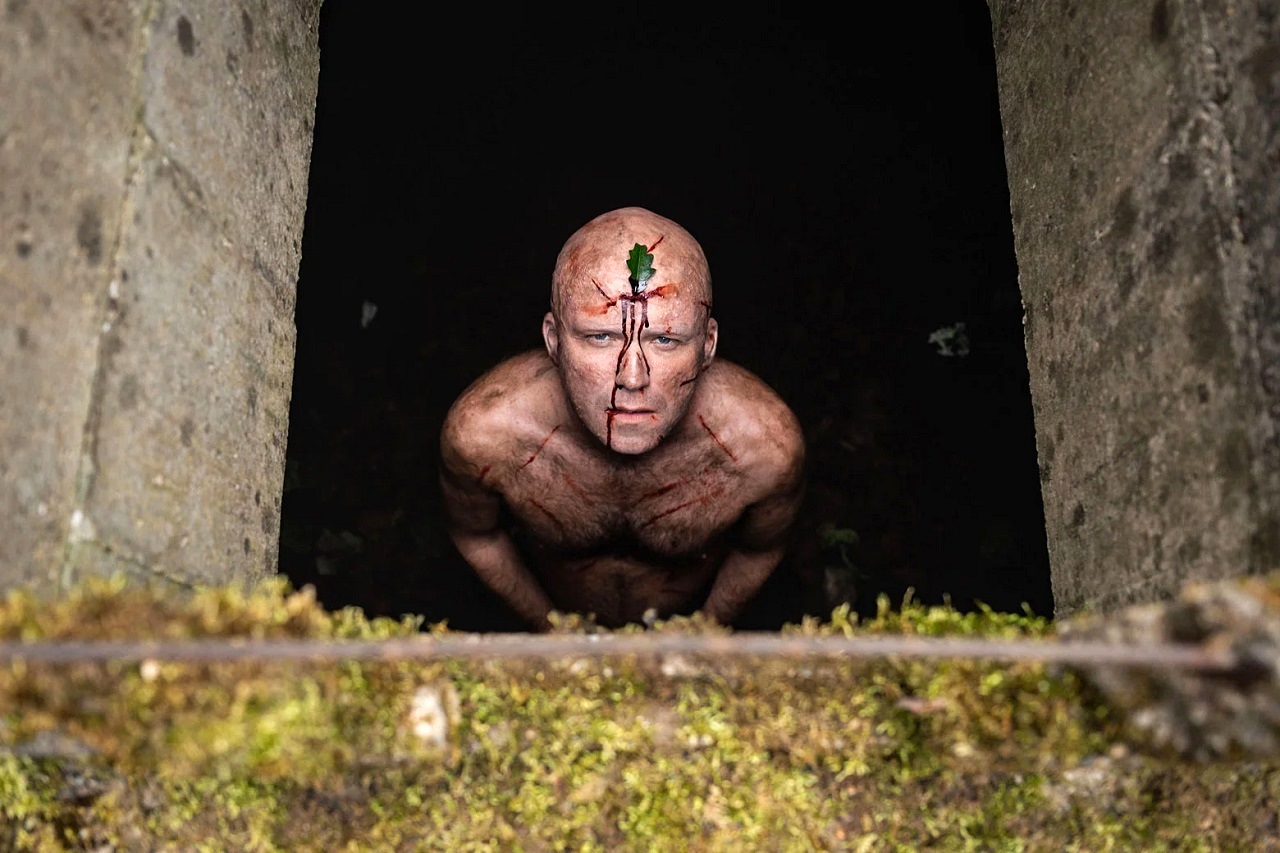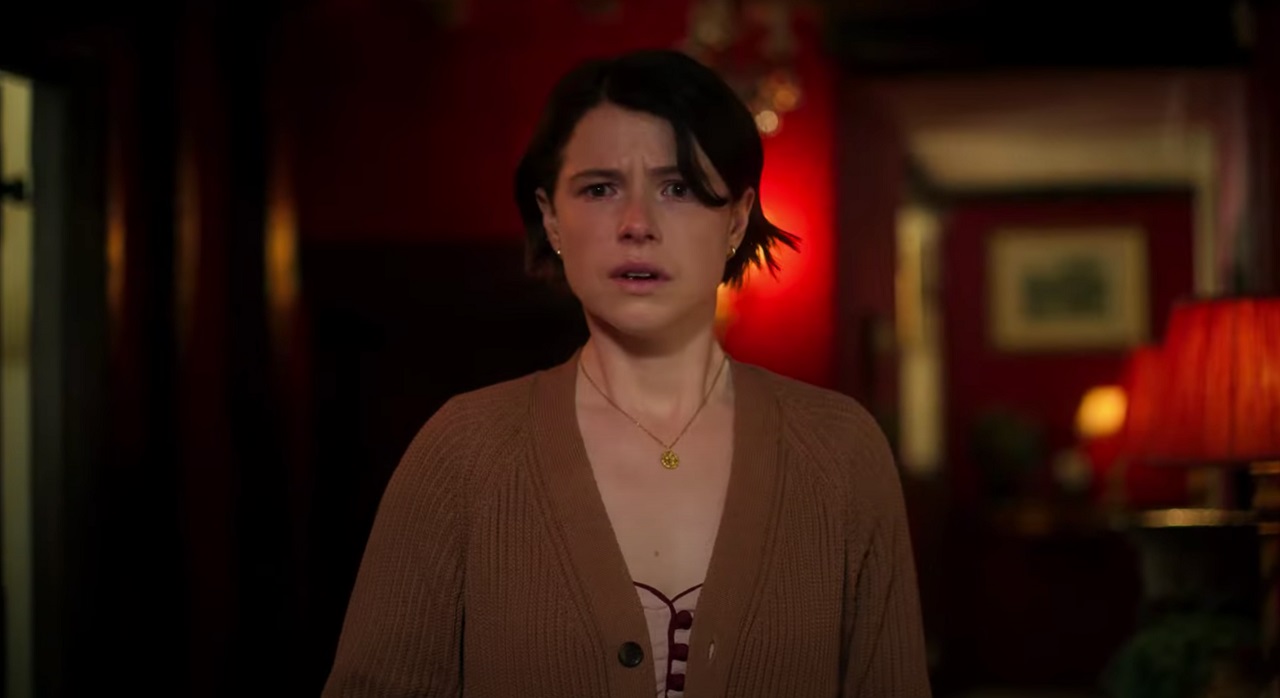Crew
Director/Screenplay – Alex Garland, Producers – Andrew MacDonald & Allon Reich, Photography – Ron Hardy, Music – Geoff Barrow & Ben Salisbury, Visual Effects Supervisor – David Simpson, Visual Effects – Framestore, Makeup Design – Nicole Stafford, Prosthetics Designer – Tristan Versluis, Production Design – Mark Digby. Production Company – DNA Films.
Cast
Jessie Buckley (Harper Marlowe), Rory Kinnear (Geoffrey), Paapa Essiedu (James Marlowe), Gayle Rankin (Riley), Sarah Twomey (Police Officer Frieda)
Plot
Harper Marlowe gets away from London and rents a house in the village of Cotson. She tells the locals that she has just gotten divorced but she is actually struggling to process the death of her husband James. She tried to leave only for him to threaten to kill himself if she did and then jump (or maybe fall) from the balcony of the apartment. As she settles in and explores the village, she is followed by a nude man. After the man tries to break into her house, he is taken away by police. Harper begins to find the attitudes of the men around the village, who all oddly resemble each other, dismissive and unhelpful, including the vicar blaming her for James’s death. She finds the naked man has been released because the police had nothing to hold him on. Home alone at night, she is terrorised as locals surround the house.
Alex Garland emerged as a novelist in the 1990s, having a best-seller The Beach (1996), which he adapted to the screen as the Danny Boyle film The Beach (2000). Garland and Boyle subsequently collaborated on 28 Days Later (2002), one of the key films that started the zombie revival of the 2000s. This led Garland on a new path as a screenwriter and he turned out scripts for other Danny Boyle collaborations Sunshine (2007) and 28 Years Later … (2025), as well as other works like Never Let Me Go (2010) and Dredd (2012). He made his directorial debut with the acclaimed Ex Machina (2015). This was followed by Annihilation (2018) and the tv mini-series Devs (2020) and subsequent to this the near future Civil War (2024).
Men is fuelled by Garland’s fascination with The Green Man, a figure from folklore that appears in many English churches and some other cultures. The Green Man is depicted with foliage emerging from its face and body and supposedly represents a force of nature. The term The Green Man was coined in a 1939 article by Lady Raglan, who theorised that the church depictions represented something that was worshipped, although there is no clear evidence for the existence of The Green Man beyond that. In the film, Garland also winds in Sheela na-gig – an exaggerated female form that also appears in some church sculptures, although there is no cultural origin for these either. This nevertheless places Men strongly into Folk Horror territory.
I anticipated Men as I have a lot of liking for Alex Garland’s work – both Ex Machina and Devs have ranked highly in this site’s respective best of their year lists, the latter being listed as Best of 2020. Garland starts out creating an absorbing film. The countryside is beautifully photographed with the film being a triumph of colour toning that renders the landscape a verdant emerald green. Garland creates some spooky tension, particularly during the scene where Jessie Buckley converses on the phone and moves about the house while a naked Rory Kinnear wanders about outside her window unnoticed.

On the other hand, the feeling you get with Men is that Alex Garland was a hot name and had people throwing money at him and asking what he wanted to do next. As a result, he ended up pitching a film based on a series of not fully fleshed-out ideas running around in his head. That and an idea that would land the film right in the middle of Woke interests because he knew it would sell. Giving a film a title like Men is bold, declarative and surely the equivalent of waving a red flag in the current political/moral climate.
I was anticipating that Men would be a bold, incisive work in the field of gender relations. However, it is a film that never seems to conceptually gel. Jessie Buckley has guilt over her husband’s suicide (or accidental fall from the balcony) after she announced she wanted to split up and he refused to accept this. The other men in the village voice statements that are either blame her for this or minimise her concerns about the lurking nude man.
On the other hand, what is going on is confusing. After a certain point, you notice that all of the men in the village are played by actor Rory Kinnear. Quite why is a good question. It feels like an odd effect – sort of like Luis Buñuel having a role played by two actresses in That Obscure Object of Desire (1977) or the multiple actresses playing the teen girl in Todd Solondz’s Palindromes (2004), or some of the multi-role performances played by actors like Alec Guinness, Peter Sellers and Eddie Murphy. It is an effect that by its very nature distracts and takes Men from being a horror film into more of a work of Surrealism. You are constantly looking at the oddity of the effect of seeing Rory Kinnear as a teenage boy one minute, a vicar or a drunken lout the next then seeing him wandering around the garden nude painted green.

Moreover, you keep trying to make sense of it. Are the various versions of Rory Kinnear actual people who inhabit the village, or are they all different faces worn by the Green Man? In the pub, Jessie Buckley reacts as though they are all different people – indeed, she doesn’t even seem to recognise any similarity between any of the men. We also see the men reacting with other locals like the policewoman who comes to arrest the nude man, or the vicar telling the teenage boy to go away, which suggests that they are all individuals.
On the other hand, when the house comes under attack during the climactic scenes and Jessie stabs one of the men through the mail slot in the door, splitting their entire hand in two down the middle, we see that several of the Rorys have a split hand, leading you to the assumption that all of the men are facets of the same entity. The film felt interesting in these sections and I was ready to go with it to see where Alex Garland took the idea. There is the completely WTF images of various versions of Rory Kinnear crawling through the house massively pregnant and giving birth out of their back.
However, the film’s ending on a return of the dead husband makes you think all of what went on was allegorical – that maybe the other men are a projection out of Jessie’s trauma ie. she is unconsciously seeing all men as the same one but not recognising it – but exactly what is not clear. The film comes at an ending that produces an irresolute “huh?” rather than seems to dramatically knit any of this together. You are left unsure whether you just watched a horror film about one woman getting over her trauma, a film about confronting an ancient entity that wears different faces, a film about the way men treat women, or one woman’s projected fears about how men treat women.
(Nominee for Best Cinematography at this site’s Best of 2022 Awards).
Trailer here


